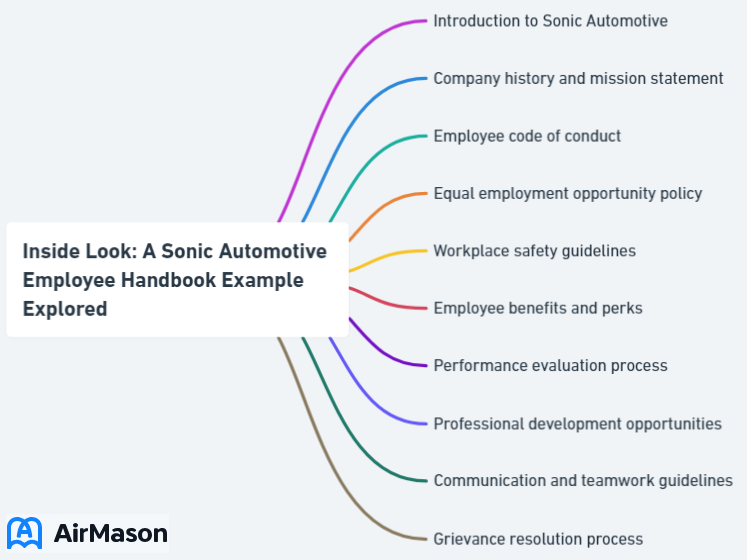
In the bustling world of the automotive industry, an effective employee handbook is essential for creating a productive and harmonious work environment. For companies like Sonic Automotive, crafting a comprehensive handbook that outlines company values, workplace policies, and compensation and benefits is pivotal in attracting and retaining top talent. This blog post will delve into the various components of a successful Sonic Automotive employee handbook example and provide insights into best practices, legal compliance, and employee rights. Are you ready to embark on this journey to create a valuable resource for your employees? Let’s get started!
Key Takeaways
- Sonic Automotive’s employee handbook should provide an overview of company ethos, workplace guidelines and compensation packages.
- Regular review and updating is essential to ensure the handbook remains relevant, incorporating changes in laws as well as employee feedback.
- Adhering to best practices such as clear language, organized layout & design, digital & print accessibility will create a useful resource for all employees.
Fortune 500 Companies Employee Handbook
In the realm of corporate governance, the Fortune 500 Companies Employee Handbook serves as an indispensable guide, outlining the principles and policies that govern the workforce within these esteemed organizations. This comprehensive document meticulously details the expectations, rights, and responsibilities of employees, providing a roadmap for a harmonious and productive work environment. As a cornerstone of organizational culture, the Fortune 500 Companies Employee Handbook not only imparts a clear understanding of company values but also ensures consistent adherence to industry standards. From codes of conduct to performance expectations, this handbook serves as a crucial tool for both new hires and seasoned professionals, fostering a unified and compliant workforce across the spectrum of Fortune 500 enterprises.
Creating an Effective Employee Handbook for Sonic Automotive
An efficient Sonic Automotive employee handbook should include significant elements like company ethos, workplace guidelines, and compensation packages. Providing an in-depth overview of these facets ensures that employees comprehend the company’s expectations and their rights, leading to a more harmonious and united work environment.
Company Culture and Values
For all organizations, particularly Sonic Automotive, clear communication of the company’s ethos and values in the employee handbook is paramount. Doing so not only promotes a positive work environment but also aligns employees with the company’s mission. Sonic Automotive upholds principles of:
- Selflessness
- Communalism
- Listening
- Friendliness
- Empowerment
- Honesty
These principles serve as the material foundation for the company’s culture and values. By outlining these principles and the company’s mission statement, employees are given a sense of purpose and direction.
The Board of Directors at Sonic Automotive plays a pivotal role in cultivating and preserving the company’s ethos and values. They are selected based on their ability to represent the interests of all the Company’s stakeholders and their diversity of skills, backgrounds, and expertise. With three standing committees established to audit and guide essential aspects of Sonic’s business, employees can trust that the company’s leadership is dedicated to upholding its values and providing an exceptional automotive experience to all customers.

Workplace Policies
Workplace guidelines form an integral part of an employee handbook, as they establish distinct expectations for employees and aid in resolving possible conflicts. Some examples of these policies include attendance, dress code, and code of conduct. Sonic Automotive’s current workplace policies encompass PTO and vacation policy, business conduct and ethics policy, non-discrimination policy, anti-harassment policy, workplace safety policy, and wage/hour guidelines and controls.
To convey these workplace guidelines effectively, it’s pivotal to:
- Create an easily readable handbook that is introduced during orientation
- Gather feedback from employees to ensure clarity and understanding
- Employ visuals, such as infographics or diagrams, to enhance comprehension
- Keep the handbook updated with any changes or new policies
- Ensure legal compliance by including all necessary information and regulations
By following these steps in accordance with the company’s guidelines, employees can easily understand the company’s expectations, leading to a more harmonious and productive work environment.
Compensation and Benefits

A thorough and transparent summary of remuneration and benefits, including accounting for salary, bonuses, and insurance, is key to attracting and retaining competent employees. By detailing this information, the employee handbook provides clarity and answers to employee questions regarding the company’s policies and benefits.
For example, Sonic Automotive offers its employees a comprehensive package that includes:
- Medical, dental, vision, and life insurance
- Retirement plans
- Disability insurance
- Employee discounts
These benefits can be considered valuable assets for employees.
In addition to these benefits, Sonic Automotive also offers eligible employees the opportunity to establish a SIMPLE 401(k) plan, with contribution limits allowing employees to defer up to $13,500 of their wages. Providing this information in the employee handbook, Sonic Automotive maintains transparency and aids employees in making decisions about their remuneration and benefits.
Legal Compliance and Employee Rights
Legal conformity and employee rights are vital parts of an employee handbook. By covering significant areas such as employment laws, health and safety guidelines, and employee privacy and data protection, the handbook aids in ensuring that both the company and its employees operate in line with all relevant laws and regulations.
Additionally, including information about employee rights fosters a sense of trust and fairness within the workplace.
Equitable Holdings Employee Handbook Example
In this illustrative Equitable Holdings Employee Handbook Example, we showcase the comprehensive and employee-centric approach that defines our organizational culture. The “Equitable Holdings Employee Handbook Example” serves as a blueprint for fostering a workplace environment where diversity, inclusion, and mutual respect are fundamental values. Through this handbook, we aim to provide clear guidelines on professional conduct, employee benefits, and the principles that guide our organization. This exemplar handbook reflects our commitment to creating an equitable and supportive workplace for all our team members. It not only outlines the policies but also emphasizes our dedication to fostering a culture that values the well-being and success of every individual within Equitable Holdings.
Employment Laws
To ensure a legally compliant workplace, it is vital for the employee handbook to inform employees of relevant employment laws. These include anti-discrimination and harassment policies, minimum wage and overtime laws, and any other state, county, or local laws that may apply to Sonic Automotive. By providing employees with this information, the handbook empowers them to understand their rights and protections under the law.
Failure to adhere to employment laws can result in:
- Wage and hour violations
- Decreased productivity
- Government agency reviews
- Costly claims and lawsuits
- Penalties and fines
- HR non-compliance penalties
Therefore, it is of utmost importance that Sonic Automotive’s employee handbook is up-to-date with all applicable laws and regulations, ensuring a legally compliant and safe work environment for all employees.
Health and Safety Regulations
Promoting a safe work environment is essential for any company, and Sonic Automotive is no exception. To achieve this, the employee handbook should outline health and safety regulations, such as those issued by:
- U.S. Department of Labor’s Occupational Safety and Health Administration (OSHA)
- National Highway Traffic Safety Administration (NHTSA)
- Environmental Protection Agency (EPA)
By providing employees with information on their rights and responsibilities regarding health and safety, the handbook ensures that they are aware of the necessary precautions and procedures to maintain a secure workplace.
Sonic Automotive should also include details on how the company adheres to health department regulations and takes the necessary steps to prevent accidents and injuries in the workplace. By doing so, the employee handbook serves as a valuable resource for employees, promoting a safe and healthy work environment.
Employee Privacy and Data Security
Protecting employee privacy and data security is crucial in maintaining trust between the company and its employees. The employee handbook should include policies and procedures that address the collection, storage, and use of employee data, as well as measures to protect this sensitive information. Some examples of measures that can be implemented include:
- Implementing secure password policies
- Encrypting sensitive employee data
- Regularly updating security software and systems
- Conducting regular security audits
- Providing training to employees on data security best practices
Sonic Automotive, for example, employs reasonable physical, electronic, and managerial measures to ensure the security of employee privacy and data.
By outlining these policies in the employee handbook, employees can understand their rights in relation to their personal information and how the company safeguards their privacy. Furthermore, the handbook should provide information on how employees can report any violations or concerns regarding their privacy and data security, as well as the steps the company will take to address such issues.
Developing and Maintaining Your Employee Handbook
Developing and maintaining an employee handbook is an ongoing process that requires establishing clear objectives, regularly updating and reviewing its content, and incorporating employee input and feedback. By doing so, the handbook remains relevant and useful for all employees, effectively guiding them through their tenure at Sonic Automotive.
Establishing Clear Objectives
A well-crafted employee handbook should have clear objectives, such as promoting a positive work environment, ensuring legal compliance, and setting expectations for employees. By having these objectives in place, the content and structure of the handbook can be guided accordingly, resulting in a valuable resource for both employees and management.
Clear objectives facilitate a positive work environment by providing employees with a sense of direction and purpose, minimizing confusion and ambiguity. This clarity helps to reduce misunderstandings, improve productivity, and increase job satisfaction. Additionally, clear objectives provide employees with a sense of accomplishment when they are met, boosting morale and motivation within the workforce.
Regular Updates and Reviews
To keep the employee handbook up-to-date and relevant, it’s important to frequently revise and review its content. This should be done at least annually or when there are significant changes in the organization or industry. By doing so, the handbook stays in line with any alterations to company policies, procedures, or legal requirements, ensuring employees have the most up-to-date information.
During the review process, it’s important to consider any changes in laws and regulations, along with employee feedback. By incorporating this feedback, the handbook can be updated to better serve the needs and concerns of employees, ultimately leading to a more comprehensive and useful resource.
Employee Input and Feedback
Taking into account employee input and feedback is vital when developing and updating an employee handbook. By including their perspectives and understanding, organizations can ensure that the handbook accurately reflects the needs and concerns of their employees, leading to improved job satisfaction, productivity, and loyalty. Furthermore, employee feedback helps to identify areas of improvement and ensures that policies and procedures are effective and in line with the organization’s objectives.
Various methods can be employed to collect employee feedback for an employee handbook, such as:
- Surveys
- Interviews
- Feedback sessions
- Review teams
- HR consultation
By incorporating employee feedback and regularly reviewing and updating the handbook, companies like Sonic Automotive can create a valuable resource that caters to the needs and concerns of their workforce.
Employee Handbook Best Practices

Crafting an efficient employee handbook requires adhering to certain best practices like using lucid and succinct language, maintaining an organized layout and design, and ensuring digital and print availability. By adhering to these best practices, the handbook becomes a user-friendly and valuable resource for all employees.
Clear and Concise Language
Using lucid and succinct language in an employee handbook is pivotal for ensuring effective communication, transparency, consistency, and accountability. By employing straightforward language and avoiding jargon, legalese, and overly technical terms, employees can better understand the handbook’s content, minimizing the risk of confusion and misinterpretations. Furthermore, clear and concise language helps to maintain a positive and professional atmosphere in the workplace.
Some techniques for composing in an intelligible and succinct manner include:
- Using brevity
- Employing words that are easily understood
- Writing in the active voice
- Prioritizing the primary points of your subject
By adhering to these guidelines, the employee handbook becomes a clear and accessible resource for all employees.
Organized Layout and Design
An organized layout and design play a vital role in making the employee handbook user-friendly and easy to navigate. By dividing the content into distinct sections with headings and subheadings, employees can quickly locate the information they need. Additionally, incorporating visuals and images can enhance engagement, comprehension, and interest.
Some examples of effective employee handbook designs include:
- GitLab
- Nordstrom
- Valve
- Zappos
- Disqus Culture Book
- HubSpot Culture Code
By following these successful examples and incorporating an organized layout and design, the employee handbook becomes a valuable resource that employees can easily access and understand.
Fox Employee Handbook Example
In the Fox Employee Handbook Example, employees gain valuable insights into the company’s policies, procedures, and expectations. This comprehensive guide outlines the organization’s commitment to fostering a positive and inclusive work environment. Covering topics from workplace conduct to benefits and professional development, the Fox Employee Handbook Example serves as a crucial resource for both new hires and existing team members. By familiarizing themselves with this handbook, employees can navigate their roles with clarity and contribute to a harmonious and productive workplace. This document reflects Fox’s dedication to transparent communication and the well-being of its workforce.
Digital and Print Accessibility
Providing both digital and print access to the employee handbook is vital in catering to the preferences of all employees. By providing the handbook in various formats, employees can access the information in their preferred medium, increasing the likelihood that they will read and understand its content. Additionally, digital accessibility allows for easier updates and revisions, ensuring the handbook remains current and relevant.
In order to guarantee digital and print accessibility, the employee handbook should be designed with clear language, an organized layout, and a user-friendly format. By following these guidelines and ensuring accessibility in both formats, the employee handbook becomes a valuable and easily accessible resource for all employees.
Summary
Throughout this blog post, we have explored the various components required to create a comprehensive and effective employee handbook for Sonic Automotive. By including essential elements such as company culture, workplace policies, compensation and benefits, legal compliance, employee rights, and best practices, the handbook serves as a valuable resource for both employees and management. Moreover, by incorporating employee input and feedback, regularly updating and reviewing the content, and ensuring digital and print accessibility, the handbook remains relevant and useful for all employees.
So, whether you are just starting on the journey of creating an employee handbook or looking to enhance an existing one, remember that a well-crafted handbook is the foundation of a productive and harmonious work environment. By following the insights and guidelines presented in this blog post, you are well on your way to creating a valuable resource that will benefit both your employees and your organization.
Frequently Asked Questions
Who owns Sonic automotive?
The Smith family owns Sonic Automotive, with over 80% of the voting power due to its dual-class stock structure. Sonic is ranked 300th on the Fortune 500 list and is a member of the Russell 2000 Index.
Where is Sonic automotive headquarters?
Sonic Automotive’s headquarters is located in Charlotte, North Carolina, USA and has multiple offices around the US.
What is the mission statement of Sonic automotive?
Sonic Automotive’s mission is to provide customers with an outstanding automotive experience delivered with professionalism, integrity and enthusiasm. We strive to be the most trusted automotive retailer in the nation, finding the perfect vehicle to meet every guest’s unique needs.
What are the key elements of an effective employee handbook for Sonic Automotive?
An effective employee handbook for Sonic Automotive should include key elements such as company culture, workplace policies, compensation and benefits, legal compliance, employee rights, and best practices to ensure a successful workplace environment.
How can employee input and feedback be incorporated into the handbook?
Employee input and feedback can be incorporated into the handbook by gathering it through surveys, interviews, feedback sessions, review teams, and HR consultation. This way, the handbook will reflect the needs and concerns of employees.
Important Disclaimer:
The article presented here does not serve as a representation of the company’s actual employee handbook mentioned in this article.
Our discussions and insights regarding employee handbook are based on assumptions about what may be considered significant in the companies’ policies. These assumptions are drawn from available information and industry knowledge. Readers are advised that the content provided is for informational purposes only and should not be construed as an exact reflection of any company’s official policies or procedures. For precise and accurate details regarding a company’s employee handbook, individuals should refer directly to the company’s official documentation or consult with appropriate representatives.
Please be aware that the content on this page has been generated by using artificial intelligence language models and may contain errors, inconsistencies, or outdated information. It is provided as-is without any warranties or guarantees of accuracy. We strongly recommend using this content as a starting point for further research. We disclaim any liability for damages or losses resulting from the use or reliance on this content.